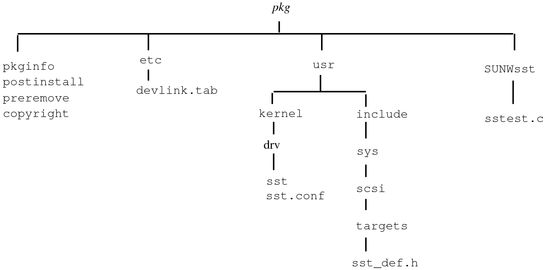|
|||
|
3. Enhancing the Functionality of a Package (Tasks) 4. Verifying and Transferring a Package 5. Case Studies of Package Creation Soliciting Input From the Administrator Creating a File at Installation and Saving It During Removal Defining Package Compatibilities and Dependencies Modifying a File by Using Standard Classes and Class Action Scripts Modifying a File by Using the sed Class and a postinstall Script Modifying a File by Using The build Class Modifying crontab Files During Installation Installing and Removing a Driver With Procedure Scripts |
Installing a Driver by Using the sed Class and Procedure ScriptsThis case study describes how to install a driver using the sed class and procedure scripts. It is also different from the previous case study (see Installing and Removing a Driver With Procedure Scripts) because this package is made up of both absolute and relocatable objects. TechniquesThis case study demonstrates the following techniques:
Approach
Case Study FilesThe pkginfo FilePKG=SUNWsst NAME=Simple SCSI Target Driver VERSION=1 CATEGORY=system ARCH=sparc VENDOR=Sun Microsystems BASEDIR=/opt CLASSES=sed The prototype FileFor example, this case study uses the hierarchical layout of the package objects shown in the figure below. Figure 5-1 Hierarchical Package Directory Structure The package objects are installed in the same places as they are in the pkg directory above. The driver modules (sst and sst.conf) are installed into /usr/kernel/drv and the include file is installed into /usr/include/sys/scsi/targets. The sst, sst.conf, and sst_def.h files are absolute objects. The test program, sstest.c, and its directory SUNWsst are relocatable; their installation location is set by the BASEDIR parameter. The remaining components of the package (all the control files) go in the top directory of the package on the development machine, except the sed class script. This is called devlink.tab after the file it modifies, and goes into etc, the directory containing the real devlink.tab file. From the pkg directory, run the pkgproto command as follows: find usr SUNWsst -print | pkgproto > prototype The output from the above command looks like this: d none usr 0775 pms mts d none usr/include 0775 pms mts d none usr/include/sys 0775 pms mts d none usr/include/sys/scsi 0775 pms mts d none usr/include/sys/scsi/targets 0775 pms mts f none usr/include/sys/scsi/targets/sst_def.h 0444 pms mts d none usr/kernel 0775 pms mts d none usr/kernel/drv 0775 pms mts f none usr/kernel/drv/sst 0664 pms mts f none usr/kernel/drv/sst.conf 0444 pms mts d none SUNWsst 0775 pms mts f none SUNWsst/sstest.c 0664 pms mts This prototype file is not yet complete. To complete this file, you need to make the following modifications:
This is the final prototype file: i pkginfo i postinstall i preremove i copyright e sed /etc/devlink.tab ? ? ? f none /usr/include/sys/scsi/targets/sst_def.h 0644 bin bin f none /usr/kernel/drv/sst 0755 root sys f none /usr/kernel/drv/sst.conf 0644 root sys d none SUNWsst 0775 root sys f none SUNWsst/sstest.c 0664 root sys The questions marks in the entry for the sed script indicate that the access permissions and ownership of the existing file on the installation machine should not be changed. The sed Class Action Script (/etc/devlink.tab)In the driver example, a sed class script is used to add an entry for the driver to the file /etc/devlink.tab. This file is used by the devlinks command to create symbolic links from /dev into /devices. This is the sed script: # sed class script to modify /etc/devlink.tab !install /name=sst;/d $i\ type=ddi_pseudo;name=sst;minor=character rsst\\A1 !remove /name=sst;/d The pkgrm command does not run the removal part of the script. You may need to add a line to the preremove script to run sed directly to remove the entry from the /etc/devlink.tab file. The postinstall Installation ScriptIn this example, all the script needs to do is run the add_drv command. # Postinstallation script for SUNWsst
# This does not apply to a client.
if [$PKG_INSTALL_ROOT = "/" -o -z $PKG_INSTALL_ROOT]; then
SAVEBASE=$BASEDIR
BASEDIR=””; export BASEDIR
/usr/sbin/add_drv sst
STATUS=$?
BASEDIR=$SAVEBASE; export BASEDIR
if [ $STATUS -eq 0 ]
then
exit 20
else
exit 2
fi
else
echo "This cannot be installed onto a client."
exit 2
fiThe add_drv command uses the BASEDIR parameter, so the script has to unset BASEDIR before running the command, and restore it afterwards. One of the actions of the add_drv command is to run devlinks, which uses the entry placed in /etc/devlink.tab by the sed class script to create the /dev entries for the driver. The exit code from the postinstall script is significant. The exit code 20 tells the pkgadd command to tell the user to reboot the system (necessary after installing a driver), and the exit code 2 tells the pkgadd command to tell the user that the installation partially failed. The preremove Removal ScriptIn the case of this driver example, it removes the links in /dev and runs the rem_drv command on the driver. # Pre removal script for the sst driver echo “Removing /dev entries” /usr/bin/rm -f /dev/rsst* echo “Deinstalling driver from the kernel” SAVEBASE=$BASEDIR BASEDIR=””; export BASEDIR /usr/sbin/rem_drv sst BASEDIR=$SAVEBASE; export BASEDIR exit The script removes the /dev entries itself; the /devices entries are removed by the rem_drv command. The copyright FileThis is a simple ASCII file containing the text of a copyright notice. The notice is displayed at the beginning of package installation exactly as it appears in the file. Copyright (c) 1999 Drivers-R-Us, Inc.
10 Device Drive, Thebus, IO 80586
All rights reserved. This product and related documentation is
protected by copyright and distributed under licenses
restricting its use, copying, distribution and decompilation.
No part of this product or related documentation may be
reproduced in any form by any means without prior written
authorization of Drivers-R-Us and its licensors, if any.
|
||
|